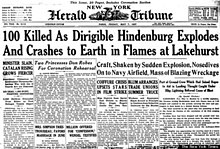
Back نيويورك هيرالد تريبيون Arabic Ню Йорк Хералд Трибюн Bulgarian New York Herald Tribune Spanish New York Herald Tribune French ניו יורק הראלד טריביון HE New York Herald Tribune ID New York Herald Tribune Italian 뉴욕 헤럴드 트리뷴 Korean New York Herald Tribune Latin New York Herald Tribune NB
 New York Herald Tribune cover on May 7, 1937, covering the Hindenburg disaster | |
| Owner(s) |
|
|---|---|
| Founder(s) |
|
| Publisher |
|
| Founded | March 19, 1924 (as New York Herald New York Tribune) |
| Political alignment | Rockefeller Republican |
| Language | English |
| Ceased publication |
|
| Headquarters | New York City, New York, U.S. |
| Country | United States |
| Circulation | 412,000 Daily (1962)[1] |
| Sister newspapers | International Herald Tribune |
| ISSN | 1941-0646 |
| OCLC number | 9405828 |
The New York Herald Tribune was a newspaper published between 1924 and 1966. It was created in 1924 when Ogden Mills Reid of the New York Tribune acquired the New York Herald. It was regarded as a "writer's newspaper"[2] and competed with The New York Times in the daily morning market.[3] The paper won twelve Pulitzer Prizes during its lifetime.[a]
A "Republican paper, a Protestant paper and a paper more representative of the suburbs than the ethnic mix of the city", according to one later reporter,[2] the Tribune generally did not match the comprehensiveness of The New York Times' coverage. Its national, international and business coverage, however, was generally viewed as among the best in the industry, as was its overall style.[5] At one time or another, the paper's writers included Dorothy Thompson, Red Smith, Roger Kahn, Richard Watts Jr., Homer Bigart, Walter Kerr, Walter Lippmann, St. Clair McKelway, Judith Crist, Dick Schaap, Tom Wolfe, John Steinbeck, and Jimmy Breslin. Editorially, the newspaper was the voice for eastern Republicans, later referred to as Rockefeller Republicans, and espoused a pro-business, internationalist viewpoint.
The paper, first owned by the Reid family, struggled financially for most of its life and rarely generated enough profit for growth or capital improvements; the Reids subsidized the Herald Tribune through the paper's early years. However, it enjoyed prosperity during World War II and by the end of the conflict had pulled close to the Times in ad revenue. A series of disastrous business decisions, combined with aggressive competition from the Times and poor leadership from the Reid family, left the Herald Tribune far behind its rival.
In 1958, the Reids sold the Herald Tribune to John Hay Whitney, a multimillionaire Wall Street investor who was serving as ambassador to the United Kingdom at the time. Under his leadership, the Tribune experimented with new layouts and new approaches to reporting the news and made important contributions to the body of New Journalism that developed in the 1960s. The paper steadily revived under Whitney, but a 114-day newspaper strike stopped the Herald Tribune's gains and ushered in four years of strife with labor unions, particularly the local chapter of the International Typographical Union. Faced with mounting losses, Whitney attempted to merge the Herald Tribune with the New York World-Telegram and the New York Journal-American in the spring of 1966; the proposed merger led to another lengthy strike, and on August 15, 1966, Whitney announced the closure of the Herald Tribune. Combined with investments in the World Journal Tribune, Whitney spent $39.5 million (equivalent to $370,710,006 in 2023 dollars[6]) in his attempts to keep the newspaper alive.[7]
After the New York Herald Tribune closed, the Times and The Washington Post, joined by Whitney, entered an agreement to operate the International Herald Tribune, the paper's former Paris publication. By 1967, the paper was owned jointly by Whitney Communications, The Washington Post and The New York Times. The International Herald Tribune, also known as the "IHT", ceased publication in 2013.[8]
- ^ Kluger 1986, p. 647.
- ^ a b Roberts 2013.
- ^ Kluger 1986, p. 8.
- ^ "Pulitzer Prize web page". Pulitzer Prizes. Retrieved February 18, 2017.
- ^ Kluger 1986, p. 9.
- ^ 1634–1699: McCusker, J. J. (1997). How Much Is That in Real Money? A Historical Price Index for Use as a Deflator of Money Values in the Economy of the United States: Addenda et Corrigenda (PDF). American Antiquarian Society. 1700–1799: McCusker, J. J. (1992). How Much Is That in Real Money? A Historical Price Index for Use as a Deflator of Money Values in the Economy of the United States (PDF). American Antiquarian Society. 1800–present: Federal Reserve Bank of Minneapolis. "Consumer Price Index (estimate) 1800–". Retrieved February 29, 2024.
- ^ Kluger 1986, p. 736.
- ^ "No more IHT". Deutsche Welle. October 15, 2013.
Cite error: There are <ref group=lower-alpha> tags or {{efn}} templates on this page, but the references will not show without a {{reflist|group=lower-alpha}} template or {{notelist}} template (see the help page).
